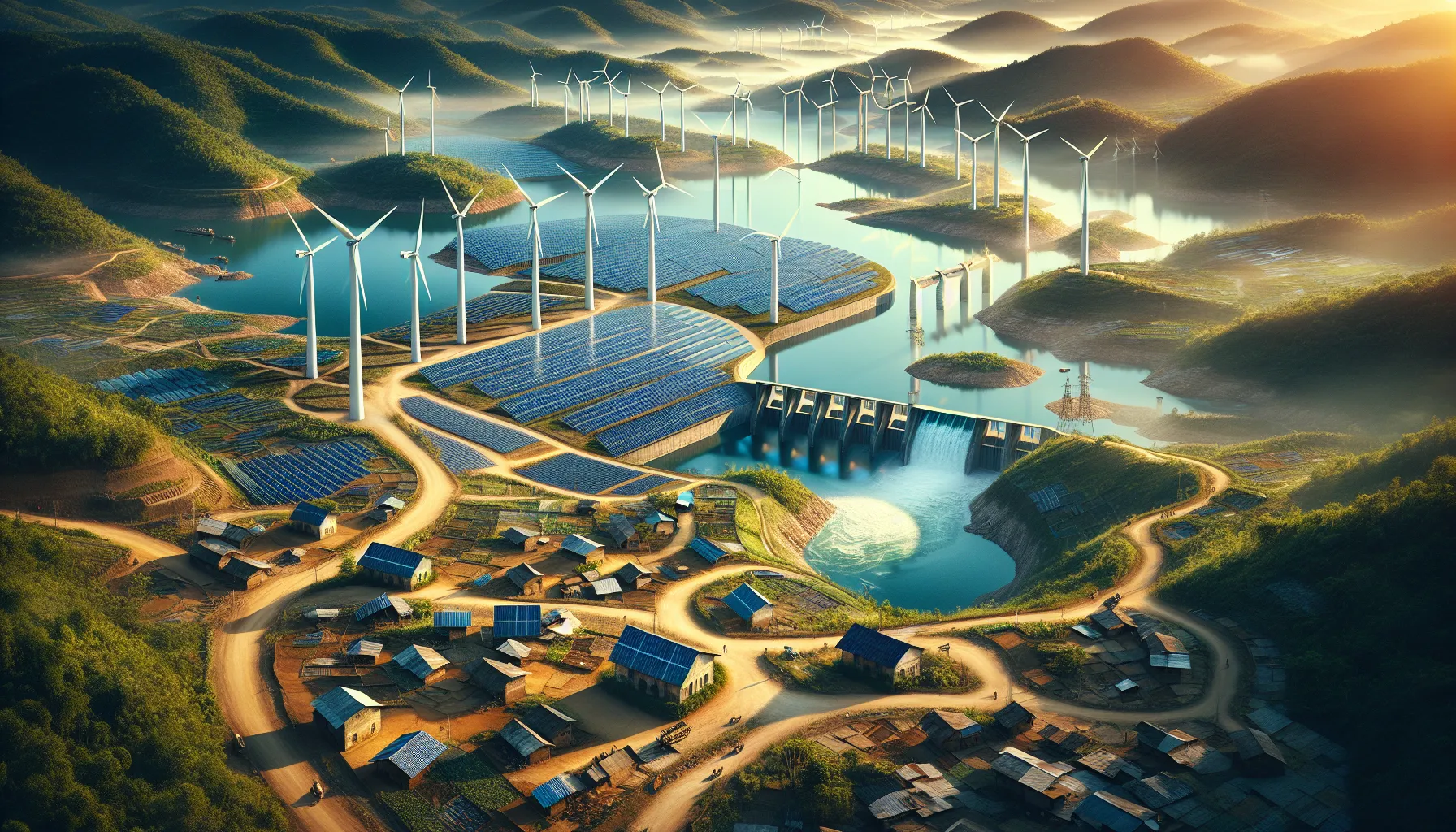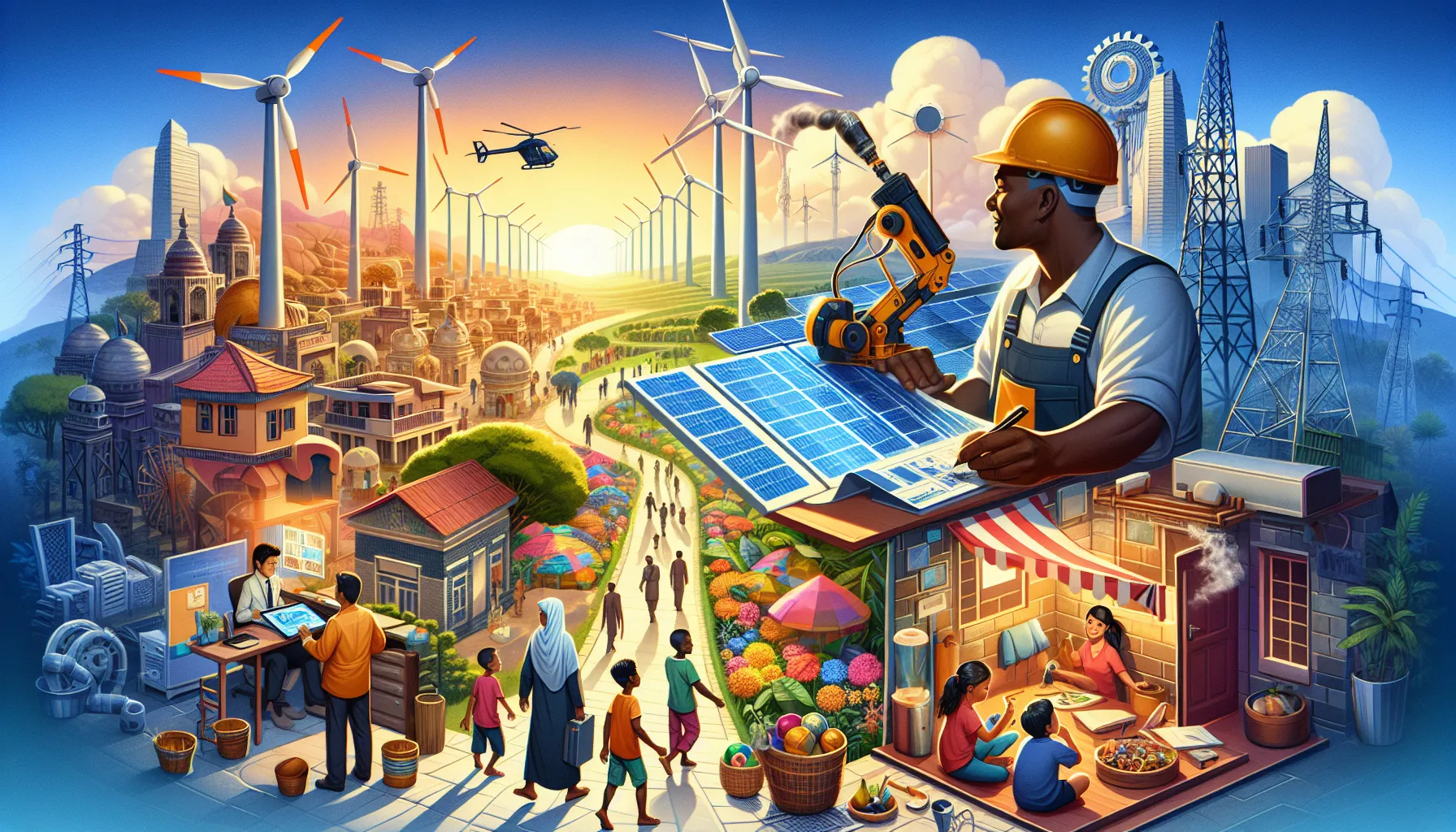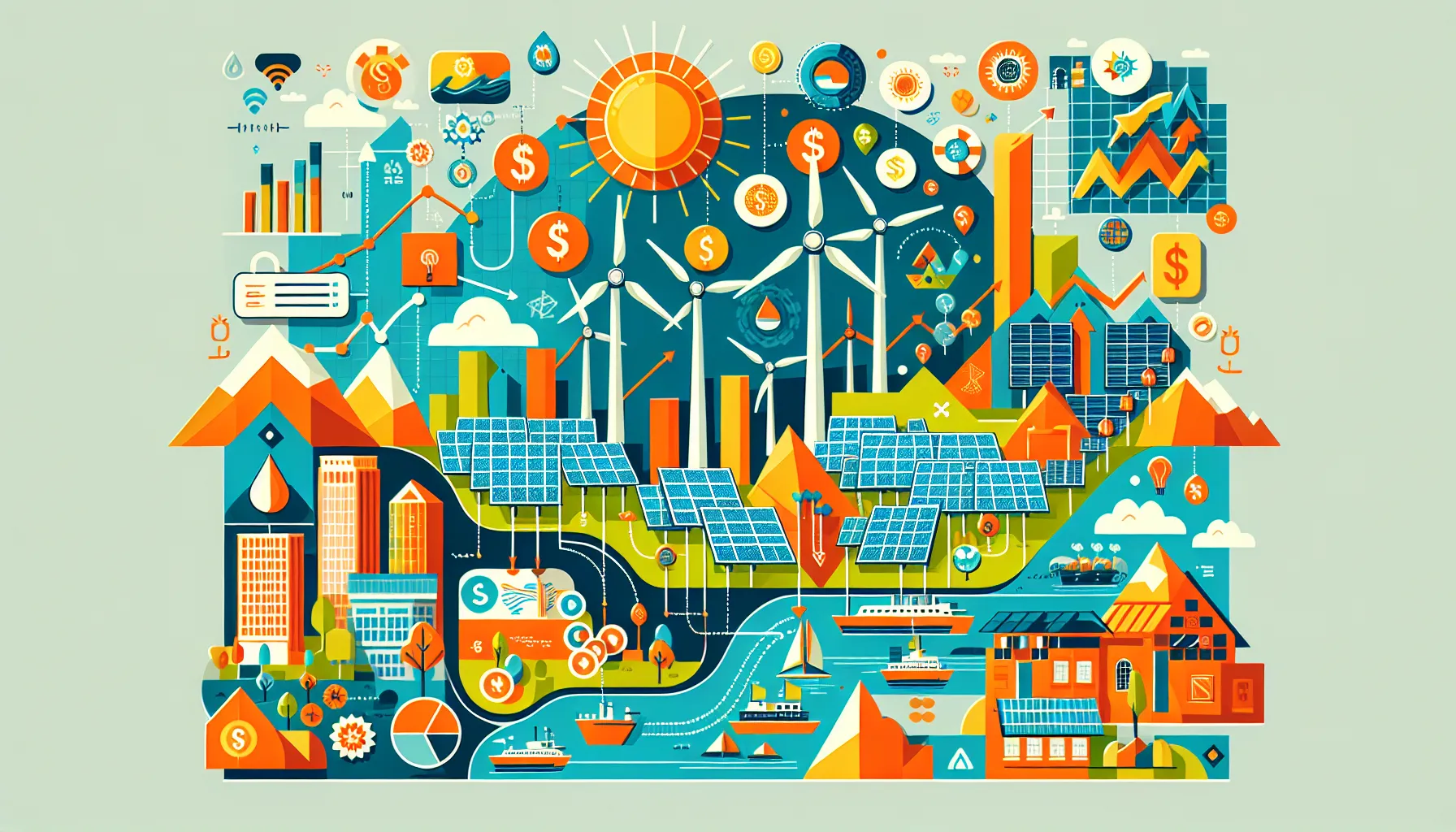Welcome to our IELTS Reading practice session focusing on the topic “How Renewable Energy is Driving Economic Growth in Developing Nations.” This comprehensive practice test will help you prepare for the IELTS Reading section by providing a full-length exam with three passages of increasing difficulty, along with a variety of question types typically found in the actual IELTS test.
Nội dung bài viết
- Introduction
- Practice Test
- Passage 1 (Easy Text)
- The Rise of Renewable Energy in Developing Countries
- Questions 1-5
- Questions 6-10
- Passage 2 (Medium Text)
- Economic Impacts of Renewable Energy in Emerging Markets
- Questions 11-15
- Questions 16-20
- Passage 3 (Hard Text)
- The Nexus of Renewable Energy and Economic Transformation in Developing Economies
- Questions 21-26
- Questions 27-33
- Questions 34-40
- Answer Key
- Passage 1
- Passage 2
- Passage 3
- Conclusion
Introduction
The IELTS Reading test assesses your ability to comprehend complex texts and identify key information. Today’s practice focuses on the impact of renewable energy on economic development in emerging economies. This topic is not only relevant for the IELTS exam but also crucial for understanding global sustainability efforts and economic trends.
Practice Test
Passage 1 (Easy Text)
The Rise of Renewable Energy in Developing Countries
Renewable energy has become a cornerstone of economic development in many emerging nations. As the world grapples with climate change and the need for sustainable energy sources, developing countries are increasingly turning to renewable options to power their growth. This shift is not only environmentally beneficial but also proving to be a significant driver of economic progress.
In recent years, countries like India, Brazil, and Kenya have made substantial investments in renewable energy infrastructure. These investments have led to the creation of new jobs, reduced reliance on expensive fossil fuel imports, and improved energy access in rural areas. For instance, India’s ambitious solar energy projects have not only increased the country’s power generation capacity but also created thousands of jobs in manufacturing, installation, and maintenance sectors.
The adoption of renewable energy technologies has also sparked innovation and entrepreneurship in these nations. Local companies are developing solutions tailored to their specific needs, such as off-grid solar systems for remote villages or biomass converters for agricultural waste. This homegrown innovation is fostering a new generation of green tech startups and attracting foreign investment.
 Renewable Energy Sources in Developing Countries
Renewable Energy Sources in Developing Countries
Moreover, the decreasing costs of renewable technologies have made them increasingly competitive with traditional energy sources. In many developing countries, solar and wind power are now cheaper than coal or gas-fired electricity. This cost-effectiveness is allowing governments to redirect funds previously spent on fossil fuel subsidies towards other areas of economic development, such as education and healthcare.
The transition to renewable energy is also improving energy security in developing nations. By reducing dependence on imported fossil fuels, these countries are less vulnerable to price fluctuations in the global energy market. This stability contributes to a more predictable economic environment, which is crucial for long-term growth and investment.
Questions 1-5
Do the following statements agree with the information given in the Reading Passage?
Write:
- TRUE if the statement agrees with the information
- FALSE if the statement contradicts the information
- NOT GIVEN if there is no information on this
- Renewable energy is becoming increasingly important for economic growth in developing countries.
- India, Brazil, and Kenya have all invested heavily in nuclear energy.
- The adoption of renewable energy has led to job creation in various sectors.
- Renewable energy is always more expensive than traditional energy sources in developing countries.
- The transition to renewable energy is helping developing countries become less dependent on imported fossil fuels.
Questions 6-10
Complete the sentences below.
Choose NO MORE THAN TWO WORDS from the passage for each answer.
- India’s solar energy projects have increased the country’s power .
- Local companies in developing countries are creating for remote villages.
- The development of green technologies is attracting to developing nations.
- Governments can redirect money previously used for to other areas like education and healthcare.
- Reducing dependence on imported fossil fuels contributes to a more ___ economic environment.
Passage 2 (Medium Text)
Economic Impacts of Renewable Energy in Emerging Markets
The proliferation of renewable energy technologies in developing nations is reshaping their economic landscapes in profound ways. While the environmental benefits of clean energy are well-documented, the economic ramifications are equally significant and multifaceted. This shift towards sustainability is not merely a trend but a fundamental restructuring of energy systems with far-reaching consequences for economic growth and development.
One of the most immediate and tangible impacts of renewable energy adoption is job creation. The renewable energy sector has become a substantial employer in many developing countries, offering a diverse range of employment opportunities. From solar panel technicians to wind farm engineers, and from biofuel researchers to energy policy analysts, the industry is generating jobs across various skill levels and educational backgrounds. This employment boom is particularly crucial for countries grappling with high unemployment rates, especially among youth.
Furthermore, the localization of energy production through renewable sources is fostering energy independence and reducing the economic vulnerability associated with fossil fuel imports. Many developing nations have historically been at the mercy of volatile international oil prices, which can wreak havoc on their economies. By investing in domestic renewable energy production, these countries are insulating themselves from such external shocks. This newfound energy security translates into more stable economies, reduced trade deficits, and improved fiscal health.
The renewable energy sector is also catalyzing innovation and technological advancement in developing nations. As these countries invest in clean energy infrastructure, they are not merely importing technologies but increasingly developing their own. This indigenous innovation is spurring the growth of local industries and creating opportunities for technology exports. Countries like China and India, once primarily seen as markets for Western technology, are now becoming global leaders in renewable energy innovation and manufacturing.
Moreover, the decentralized nature of many renewable energy systems, particularly solar and small-scale hydro, is proving to be a boon for rural electrification efforts. In regions where extending the traditional power grid is prohibitively expensive, renewable energy offers a cost-effective alternative. This improved access to electricity in rural areas is driving economic activity, enabling the establishment of small businesses, extending working hours, and improving educational outcomes through better lighting and access to information technology.
The financial sector in developing countries is also evolving in response to the renewable energy boom. New financial products and services are emerging to support renewable energy projects, from microloans for household solar systems to large-scale project finance for utility-scale installations. This is not only creating opportunities within the financial sector itself but also improving access to capital for green entrepreneurs and projects.
However, the transition to renewable energy is not without its challenges. Many developing countries face obstacles such as inadequate grid infrastructure, regulatory uncertainties, and limited access to financing. Overcoming these hurdles requires concerted efforts from governments, international organizations, and the private sector. Nonetheless, the potential economic benefits of renewable energy adoption are driving policymakers and investors to find innovative solutions to these challenges.
Questions 11-15
Choose the correct letter, A, B, C, or D.
-
According to the passage, the adoption of renewable energy in developing countries is:
A) A temporary trend
B) Primarily beneficial for the environment
C) Fundamentally changing energy systems and economies
D) Only significant in a few countries -
The renewable energy sector in developing countries is:
A) Only creating high-skilled jobs
B) Generating employment across various skill levels
C) Mainly benefiting the older workforce
D) Not significantly impacting employment -
Energy independence through renewable sources:
A) Has no effect on a country’s economic stability
B) Increases vulnerability to external economic shocks
C) Helps stabilize economies and reduce trade deficits
D) Is only achievable for oil-producing nations -
The development of renewable energy technologies in developing countries:
A) Relies entirely on imported Western technology
B) Is limited to a few countries like China and India
C) Is leading to the growth of local industries and export opportunities
D) Has no impact on technological innovation -
Rural electrification through renewable energy:
A) Is too expensive to implement
B) Has no effect on local economies
C) Is driving economic activity and improving education
D) Only benefits large businesses
Questions 16-20
Complete the summary below.
Choose NO MORE THAN TWO WORDS from the passage for each answer.
The adoption of renewable energy in developing countries is having significant economic impacts. It is creating jobs in various fields, from (16) to energy policy analysts. This shift is also promoting (17) by reducing reliance on fossil fuel imports. The renewable energy sector is stimulating (18) , particularly in countries like China and India. In rural areas, renewable energy is facilitating (19) , which supports local businesses and education. The financial sector is also adapting, creating new products to support renewable energy projects. However, challenges such as inadequate (20) and regulatory issues still need to be addressed.
Passage 3 (Hard Text)
The Nexus of Renewable Energy and Economic Transformation in Developing Economies
The paradigm shift towards renewable energy in developing nations is engendering a profound economic metamorphosis that extends far beyond the mere substitution of energy sources. This transition is catalyzing a complex interplay of technological innovation, policy reform, and socio-economic transformation that is reshaping the development trajectories of these countries in unprecedented ways.
At the forefront of this transformation is the emergence of what economists term the “green economy” – a model of economic development that places sustainability and resource efficiency at its core. In this new paradigm, renewable energy serves not just as an alternative to fossil fuels, but as a cornerstone of a new economic architecture. This shift is particularly salient in developing nations, where the imperative for rapid economic growth has often conflicted with environmental concerns. The green economy model, powered by renewable energy, offers a pathway to reconcile these seemingly divergent goals.
The multiplier effect of renewable energy investments in developing economies is particularly noteworthy. Unlike traditional extractive industries, which often create enclaves of wealth with limited spillover effects, renewable energy projects tend to have more distributed economic impacts. For instance, the establishment of a solar farm not only creates direct jobs in construction and maintenance but also stimulates local manufacturing, spurs technological learning, and can lead to the development of associated service industries. This diffusion of economic benefits helps to create a more inclusive growth model, addressing one of the key challenges faced by many developing nations – the equitable distribution of economic gains.
Moreover, the renewable energy sector is proving to be a powerful catalyst for leapfrogging in technological and industrial development. Many developing countries, unburdened by entrenched fossil fuel infrastructures and interests, are able to bypass the carbon-intensive development stage that characterized the growth of now-industrialized nations. This leapfrogging is not limited to the energy sector itself but is spawning innovation ecosystems that cut across multiple industries. For example, the need for smart grids to manage variable renewable energy sources is driving advancements in digital technologies and data analytics, with applications far beyond the energy sector.
The financing landscape for renewable energy in developing countries is also undergoing a significant evolution. Innovative financing mechanisms such as green bonds, climate funds, and blended finance instruments are mobilizing capital at unprecedented scales. This influx of finance is not only funding renewable energy projects but also catalyzing broader financial sector development. Local banks and financial institutions are developing expertise in project finance and risk assessment for renewable energy, skills that are transferable to other sectors of the economy.
However, the transition to a renewable energy-based economy is not without its complexities and challenges. The intermittency of some renewable sources like solar and wind necessitates substantial investments in energy storage and grid modernization. For many developing countries with limited fiscal space, balancing these long-term investments with immediate developmental needs poses a significant challenge. Furthermore, the shift away from fossil fuels can create economic dislocations in regions dependent on traditional energy industries, necessitating carefully managed transition strategies.
The role of government policy in shaping this transition cannot be overstated. Successful integration of renewable energy into the economic fabric of developing nations requires a holistic policy approach that goes beyond mere targets for renewable energy capacity. It necessitates coordinated action across multiple policy domains – from education and skills development to industrial policy and financial regulation. Countries that have made the most progress in harnessing renewable energy for economic development, such as Morocco with its ambitious solar projects or Costa Rica with its near-100% renewable electricity, have done so through comprehensive, long-term policy frameworks.
 Renewable Energy and Economic Transformation
Renewable Energy and Economic Transformation
In conclusion, the renewable energy revolution in developing countries is far more than an energy transition; it is a fundamental economic transformation. By embracing this shift, developing nations have the opportunity to not only address their energy needs sustainably but also to forge new paths of economic development that are more inclusive, innovative, and resilient. As this transition unfolds, it promises to redraw the global economic map, potentially altering traditional patterns of economic power and influence.
Questions 21-26
Complete the sentences below.
Choose NO MORE THAN TWO WORDS from the passage for each answer.
-
The transition to renewable energy is causing a in developing countries that goes beyond just changing energy sources.
-
The “green economy” model offers a way to balance rapid economic growth with .
-
Unlike traditional industries, renewable energy projects tend to have more ___ economic impacts.
-
Many developing countries are able to ___ the carbon-intensive stage of development.
-
The need for smart grids is driving advancements in and data analytics.
-
The ___ of some renewable energy sources requires significant investments in energy storage and grid modernization.
Questions 27-33
Do the following statements agree with the claims of the writer in the Reading Passage?
Write:
- YES if the statement agrees with the claims of the writer
- NO if the statement contradicts the claims of the writer
- NOT GIVEN if it is impossible to say what the writer thinks about this
-
The green economy model is equally applicable to both developed and developing nations.
-
Renewable energy projects create more equitable economic growth compared to traditional extractive industries.
-
All developing countries are successfully implementing renewable energy strategies.
-
The renewable energy sector is driving innovation in multiple industries beyond the energy sector.
-
Traditional financial institutions are unwilling to invest in renewable energy projects in developing countries.
-
The transition to renewable energy poses no economic challenges for regions dependent on fossil fuel industries.
-
Government policy plays a crucial role in the successful integration of renewable energy into a country’s economy.
Questions 34-40
Complete the summary below.
Choose NO MORE THAN TWO WORDS from the passage for each answer.
The shift towards renewable energy in developing countries is causing a significant (34) that extends beyond the energy sector. This transition is leading to the emergence of a (35) , which prioritizes sustainability and resource efficiency. Renewable energy investments have a strong (36) , creating widespread economic benefits. Many developing countries are able to (37) the carbon-intensive stage of development, fostering innovation across multiple sectors. The financing landscape is evolving, with (38) mobilizing unprecedented levels of capital. However, challenges remain, including the need for investments in energy storage and grid modernization due to the (39) of some renewable sources. Successful integration of renewable energy requires a (40) approach that encompasses various policy domains.
Answer Key
Passage 1
- TRUE
- FALSE
- TRUE
- FALSE
- TRUE
- generation capacity
- off-grid systems
- foreign investment
- fossil fuel subsidies
- predictable
Passage 2
- C
- B
- C
- C
- C
- solar panel technicians
- energy independence
- indigenous innovation
- rural electrification
- grid infrastructure
Passage 3
- economic metamorphosis
- environmental concerns
- distributed
- bypass
- digital technologies
- intermittency
- NOT GIVEN
- YES
- NOT GIVEN
- YES
- NO
- NO
- YES
- economic transformation
- green economy
- multiplier effect
- bypass
- innovative financing
- intermittency
- holistic policy
Conclusion
This practice test covers various aspects of how renewable energy is driving economic growth in developing nations. It demonstrates the complex interplay between energy policy, technological innovation, and economic development. Remember to analyze the passages carefully, paying attention to key details and the overall structure of the arguments presented.
For further practice on related topics, you might find these articles helpful:
- The Rise of Renewable Energy Startups in Global Markets
- Impact of Renewable Energy on National Carbon Targets
- How Renewable Energy is Influencing Economic Competitiveness
Keep practicing and refining your reading skills. Good luck with your IELTS preparation!



